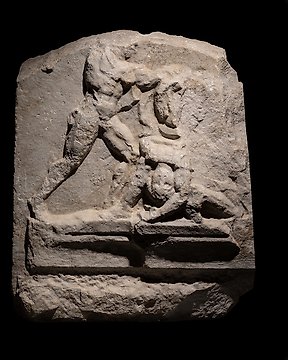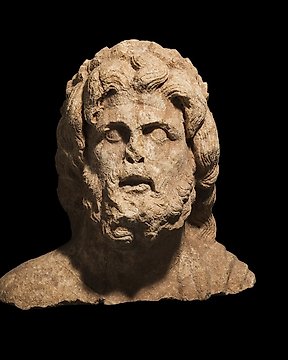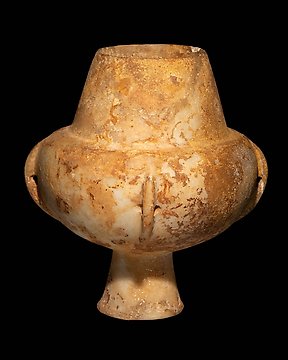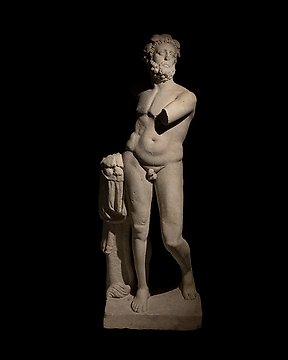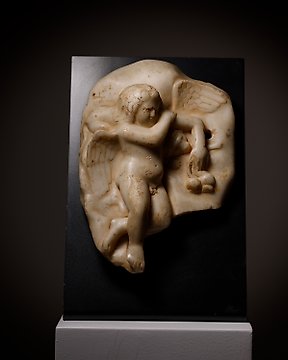All OK and with very fast shipping.
View translationAncient Greek Marble Priapus Sculpture. 2nd - 1st century BC. 24 cm height. Spanish Export License
No. 84871177
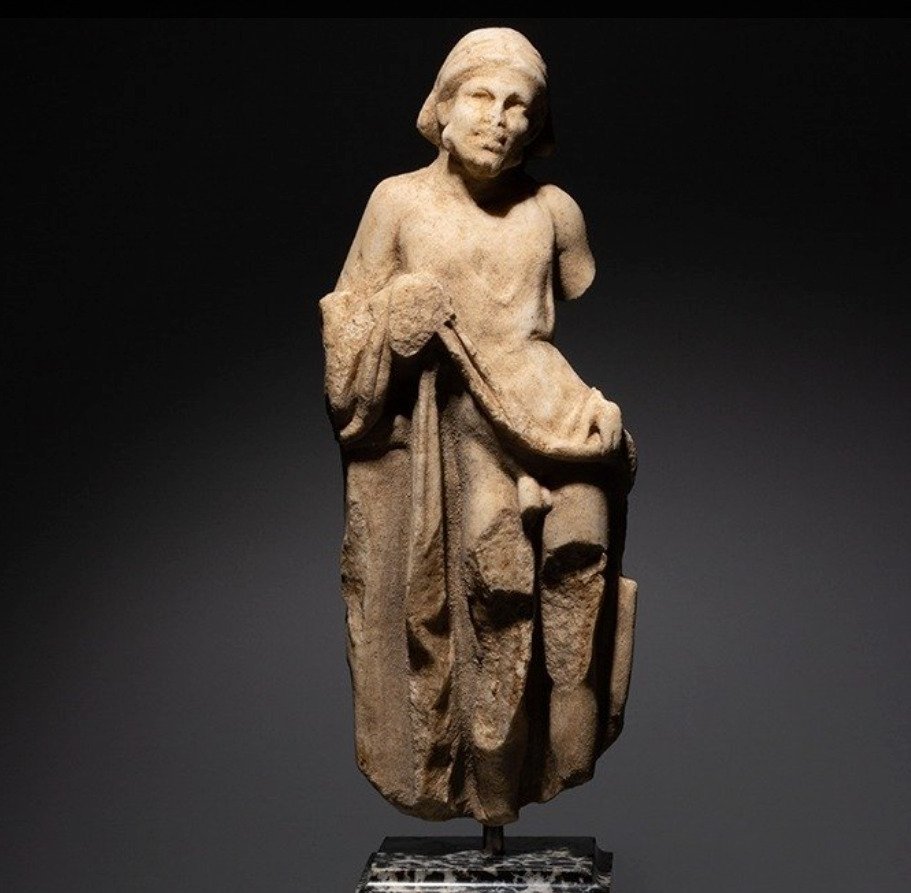
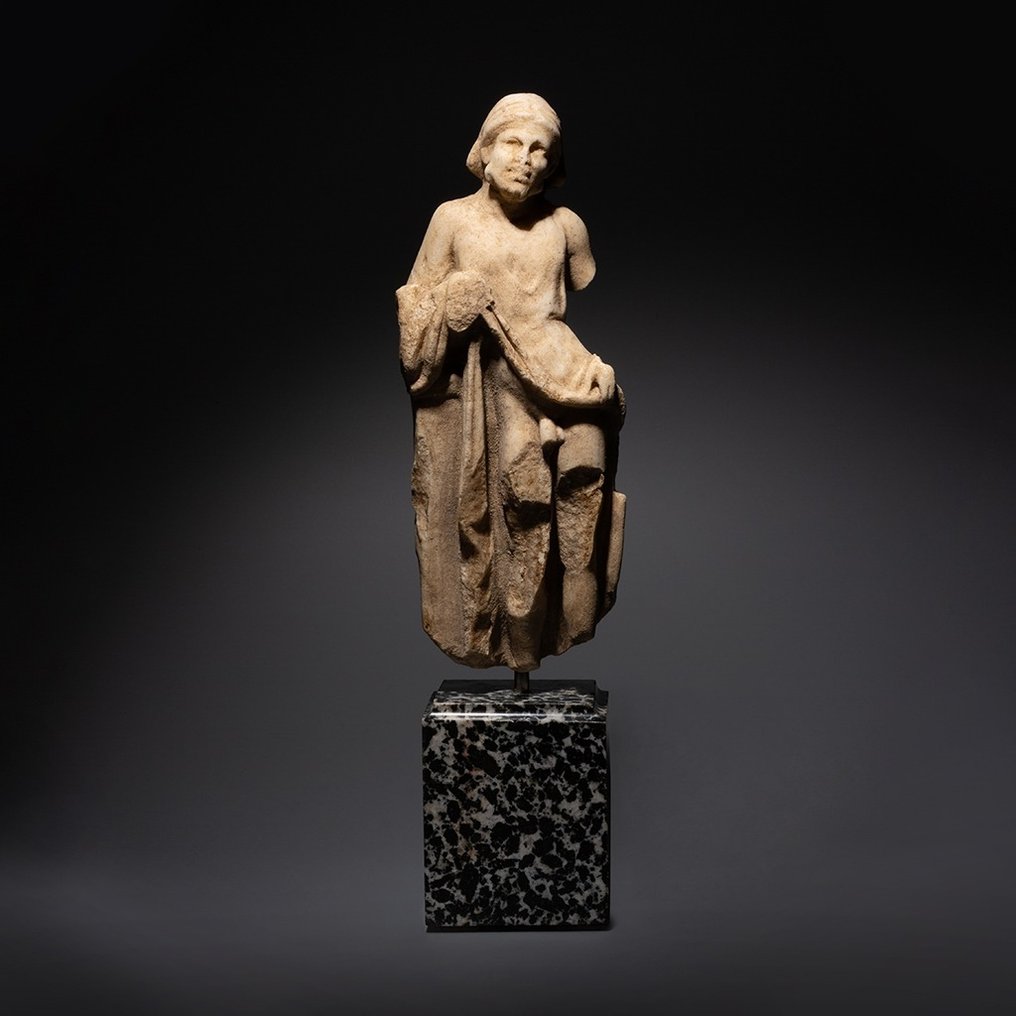
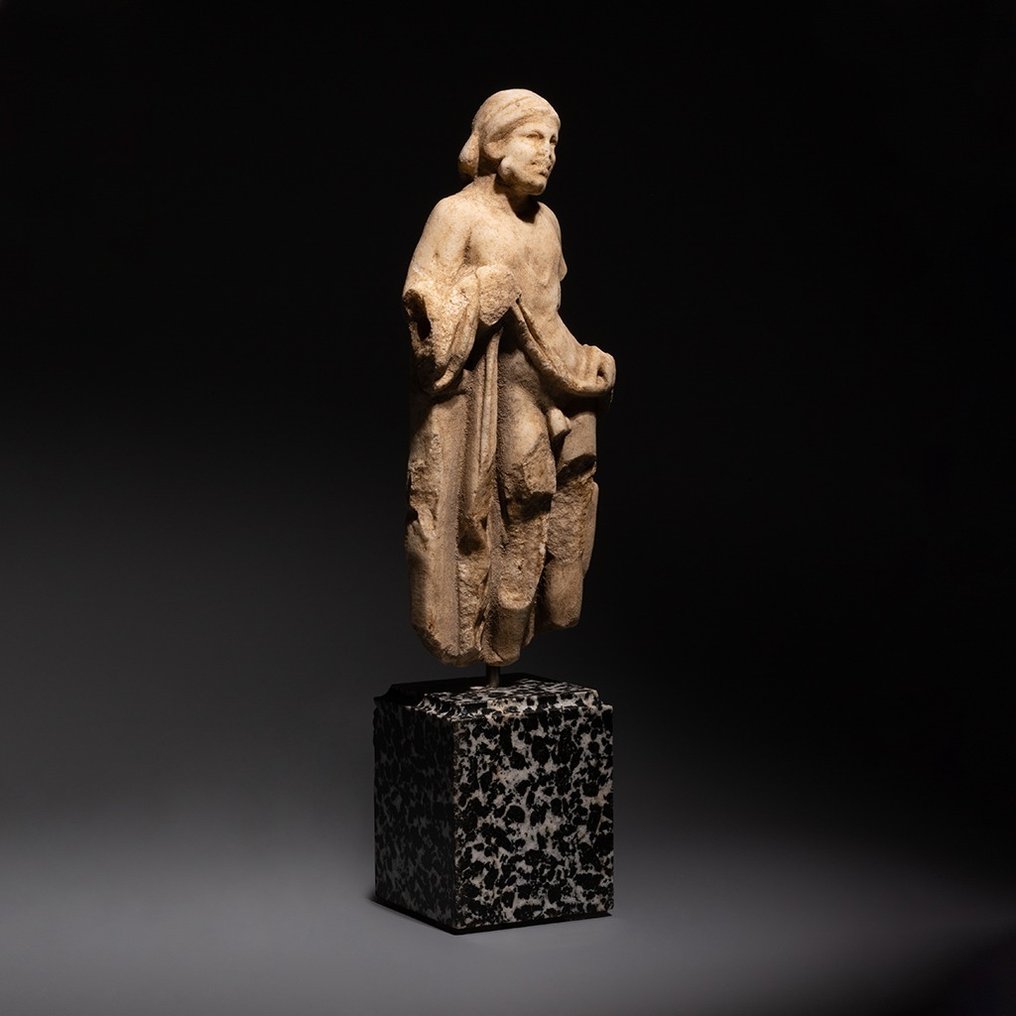
Priapus sculpture.
- Important! -
- Unique! -
Greek Hellenistic, 2nd - 1st century BC
Marble
24 cm Height (without stand)
PROVENANCE: Private collection, London, acquired 1960s - 1980s.
CONDITION: Unrestored, as found. Untouched natural patina.
DESCRIPTION:
Depicted standing, resting on a pillar, in the act of lifting the robe, discovering the genitals; the head is wrapped in a drape and a flap-like extensions beneath the chin representing a cock’s wattle. This rather unique figure of Priapus finds some paralels on groups such as the statue in Berlin which shows the head of the maenad, found before 1872 on the Quirinal near the Piazza Barberini, and a second in the National Museum at Athens where the head of Priapus is preserved. Cf. M. B. Comstock and C. C. Vermeule, Sculpture in Stone, The Greek, Roman and Etruscan collections of the Museum of Fine Arts Boston, Boston, 1976, p. 127, no. 196, for a similar Graeco-Roman group.
We did not found direct paralels for this sculpture since it was never copied in mass scale in roman times, that fact makes this sculpture very unique and unparalllel and a new form of the known corpus of images of Priapus.
Priapus was described in varying sources as the son of Aphrodite by Dionysus; as the son of Dionysus and Chione; as perhaps the father or son of Hermes; or as the son of Zeus or Pan. According to legend, Hera cursed him with inconvenient impotence (he could not sustain an erection when the time came for sexual intercourse), ugliness and foul-mindedness while he was still in Aphrodite's womb, in revenge for the hero Paris having the temerity to judge Aphrodite more beautiful than Hera. The other gods refused to allow him to live on Mount Olympus and threw him down to Earth, leaving him on a hillside. He was eventually found by shepherds and was brought up by them.
Priapus joined Pan and the satyrs as a spirit of fertility and growth, though he was perennially frustrated by his impotence. In a ribald anecdote told by Ovid, he attempted to rape the goddess Hestia but was thwarted by an ass, whose braying caused him to lose his erection at the critical moment and woke Hestia. The episode gave him a lasting hatred of asses and a willingness to see them killed in his honour. The emblem of his lustful nature was his permanent erection and his large penis.
The first extant mention of Priapus is in the eponymous comedy Priapus, written in the 4th century BC by Xenarchus. Originally worshipped by Greek colonists in Lampsacus in Asia Minor, the cult of Priapus spread to mainland Greece and eventually to Italy during the 3rd century BC. Lucian (De saltatione) tells that in Bithynia Priapus was accounted as a warlike god, a rustic tutor to the infant Ares, "who taught him dancing first and war only afterwards," Karl Kerenyi observed. Arnobius is aware of the importance accorded Priapus in this region near the Hellespont. Also, Pausanias notes:
This god is worshipped where goats and sheep pasture or there are swarms of bees; but by the people of Lampsacus he is more revered than any other god, being called by them a son of Dionysus and Aphrodite.
In later antiquity, his worship meant little more than a cult of sophisticated pornography.
Outside his "home" region in Asia Minor, Priapus was regarded as something of a joke by urban dwellers. However, he played a more important role in the countryside, where he was seen as a guardian deity. He was regarded as the patron god of sailors and fishermen and others in need of luck, and his presence was believed to avert the evil eye.
Priapus does not appear to have had an organized cult and was mostly worshiped in gardens or homes, though there are attestations of temples dedicated to the god. His sacrificial animal was the ass, but agricultural offerings (such as fruit, flowers, vegetables and fish) were also very common.
Notes:
The Seller can prove that the lot was obtained legally , provenance statement seen by Catawiki.
Important information. The seller guarantees that he is entitled to ship this lot.
The piece includes authenticity certificate.
The piece includes Spanish Export License (Passport for European Union) - If the piece is destined outside the European Union a substitution of the export permit should be requested.
#ExclusiveJurassicAntiquity
Seller's Story
Priapus sculpture.
- Important! -
- Unique! -
Greek Hellenistic, 2nd - 1st century BC
Marble
24 cm Height (without stand)
PROVENANCE: Private collection, London, acquired 1960s - 1980s.
CONDITION: Unrestored, as found. Untouched natural patina.
DESCRIPTION:
Depicted standing, resting on a pillar, in the act of lifting the robe, discovering the genitals; the head is wrapped in a drape and a flap-like extensions beneath the chin representing a cock’s wattle. This rather unique figure of Priapus finds some paralels on groups such as the statue in Berlin which shows the head of the maenad, found before 1872 on the Quirinal near the Piazza Barberini, and a second in the National Museum at Athens where the head of Priapus is preserved. Cf. M. B. Comstock and C. C. Vermeule, Sculpture in Stone, The Greek, Roman and Etruscan collections of the Museum of Fine Arts Boston, Boston, 1976, p. 127, no. 196, for a similar Graeco-Roman group.
We did not found direct paralels for this sculpture since it was never copied in mass scale in roman times, that fact makes this sculpture very unique and unparalllel and a new form of the known corpus of images of Priapus.
Priapus was described in varying sources as the son of Aphrodite by Dionysus; as the son of Dionysus and Chione; as perhaps the father or son of Hermes; or as the son of Zeus or Pan. According to legend, Hera cursed him with inconvenient impotence (he could not sustain an erection when the time came for sexual intercourse), ugliness and foul-mindedness while he was still in Aphrodite's womb, in revenge for the hero Paris having the temerity to judge Aphrodite more beautiful than Hera. The other gods refused to allow him to live on Mount Olympus and threw him down to Earth, leaving him on a hillside. He was eventually found by shepherds and was brought up by them.
Priapus joined Pan and the satyrs as a spirit of fertility and growth, though he was perennially frustrated by his impotence. In a ribald anecdote told by Ovid, he attempted to rape the goddess Hestia but was thwarted by an ass, whose braying caused him to lose his erection at the critical moment and woke Hestia. The episode gave him a lasting hatred of asses and a willingness to see them killed in his honour. The emblem of his lustful nature was his permanent erection and his large penis.
The first extant mention of Priapus is in the eponymous comedy Priapus, written in the 4th century BC by Xenarchus. Originally worshipped by Greek colonists in Lampsacus in Asia Minor, the cult of Priapus spread to mainland Greece and eventually to Italy during the 3rd century BC. Lucian (De saltatione) tells that in Bithynia Priapus was accounted as a warlike god, a rustic tutor to the infant Ares, "who taught him dancing first and war only afterwards," Karl Kerenyi observed. Arnobius is aware of the importance accorded Priapus in this region near the Hellespont. Also, Pausanias notes:
This god is worshipped where goats and sheep pasture or there are swarms of bees; but by the people of Lampsacus he is more revered than any other god, being called by them a son of Dionysus and Aphrodite.
In later antiquity, his worship meant little more than a cult of sophisticated pornography.
Outside his "home" region in Asia Minor, Priapus was regarded as something of a joke by urban dwellers. However, he played a more important role in the countryside, where he was seen as a guardian deity. He was regarded as the patron god of sailors and fishermen and others in need of luck, and his presence was believed to avert the evil eye.
Priapus does not appear to have had an organized cult and was mostly worshiped in gardens or homes, though there are attestations of temples dedicated to the god. His sacrificial animal was the ass, but agricultural offerings (such as fruit, flowers, vegetables and fish) were also very common.
Notes:
The Seller can prove that the lot was obtained legally , provenance statement seen by Catawiki.
Important information. The seller guarantees that he is entitled to ship this lot.
The piece includes authenticity certificate.
The piece includes Spanish Export License (Passport for European Union) - If the piece is destined outside the European Union a substitution of the export permit should be requested.
#ExclusiveJurassicAntiquity
Seller's Story
- 754
- 6
- 0
Prachtig schilderij. Zo blij mee. Zeer nette verkoper en zeer snelle levering.
View translationperfect ! very fast and high quality delivery !
View translationAll well! Thanks.
View translationVendeur très professionnel, top +++×
View translationPhotos trop contrastées pour bien percevoir les défauts, mais ces défauts étaient visibles pour autant. Le "Bon état" est trompeur. Sinon, envoi rapide et correctement emballé. Frais de port exagérés.
View translationGreat communication, delivery and product. Came with a well made certificate of authenticity and good packaging. Overall very happy with the purchase! Delivery is a bit expensive, but I recommend it
View translationMagnifique témoin du passé, envoyé avec tous les justificatifs, impeccable. Encore une fois très satisfait, un grand merci
View translationThank you for the Special offer and the fast shipping of this excellent piece of art!
View translationvery good description of the object, very good price for this rare item,. Fast sending (has been at my place 2 days after buying!). Definitely would buy again.
View translationSehr schön
View translationAs described, perfect logistic
View translationgreat seller, everything came as should with certificate of authenticity
View translationExceptionally well packaged, description aligned with positing received
View translationReally precious, but without sound...
View translationPainting well packed and rapidly sent!
View translationsempre grande rapidità e professionalità
View translationparfait bien reçu, merci
View translationVery satisfied with the small Greek Lekythos. As always (we have already bought several items from Bagot), the object was wrapped and sent immediately and with the greatest care.
View translationPerfect, excellent condition, good packaging, the parcel arrived without any problems… all is perfect as usual. Thank you very much and wait for an other nice piece like this one. Gilles.
View translation+++ Top vendeur professionnel comme d'habitude
View translationEmbora o custo de transporte esteja acima da média foi, realmente, muito bem executado e em embalagem cuidada. Expeditos e profissionais. Recomendo
View translationSnel en correct en goed verpakt verzonden
View translationoggetto bellissimo, fedele alla descrizione, venditore affidabile
View translationVery nice piece and fast delivery
View translationDisclaimer
The seller guarantees and can prove that the object was obtained legally. The seller was informed by Catawiki that they had to provide the documentation required by the laws and regulations in their country of residence. The seller guarantees and is entitled to sell/export this object. The seller will provide all provenance information known about the object to the buyer. The seller ensures that any necessary permits are/will be arranged. The seller will inform the buyer immediately about any delays in obtaining such permits.
The seller guarantees and can prove that the object was obtained legally. The seller was informed by Catawiki that they had to provide the documentation required by the laws and regulations in their country of residence. The seller guarantees and is entitled to sell/export this object. The seller will provide all provenance information known about the object to the buyer. The seller ensures that any necessary permits are/will be arranged. The seller will inform the buyer immediately about any delays in obtaining such permits.
